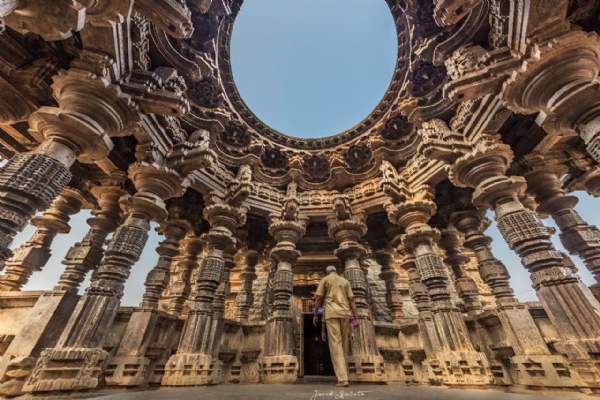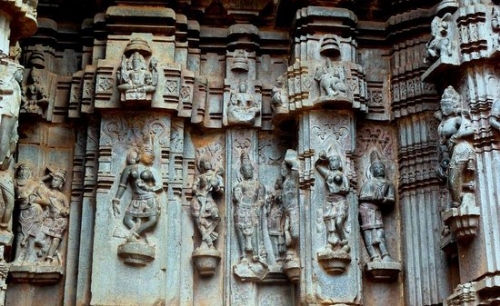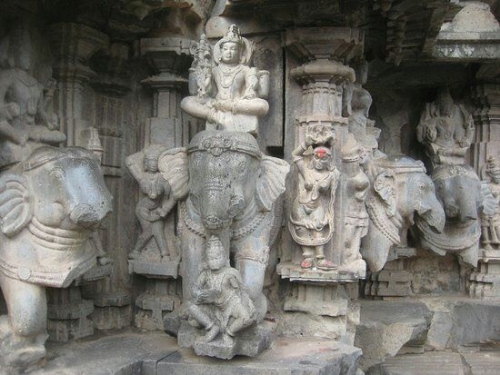Kopeshwar Temple, the architectural wonder of Khidrapur
23 Apr 2022 16:54:08
The Kopeshwar temple in the Khidrapur village, Maharashtra is one the is truly unmissable for the architecture connoisseur. This temple features some stunning architectural features from carved centuries ago. The time period in which the temple was build though, is still up for debate, but mostly is believed to be belonging to the 12th century.

Architecture | The entire Kopeshwar Temple is divided into 4 parts - Swargamandapa, Sabhamandapa, Antaral kaksha and the Garbha griha. The Garbha Griha has 2 Lingas – one that represents the Shiva as Kopeshwar. The second one represents Vishnu as Dhopeshwar - as pacifier of Shiva. Since this temple celebrates that moment, both Shiva and Vishnu are present in Linga form here.
But the Swargamandapa is the first part of the temple that you see once you step in. It is detached from the main temple having a small margin. The circular structure of it is supported on 48 pillars, each of which is beautifully carved. Seen from the outside, you can see the impression of an inverted lotus on the roof.
In the Sabha Mandapa, you will exquisitely carved pillars. The minute details made on them are sure to take your breath away. The four corners of the Sabha Mandap have major deities carved on them. Deities like Brahma, Vishnu, Ganapati, Krishna as Murlidhara, Shiva, Devi, Bhairav, Bali, Vaman, Chandra, Surya, Ardhnarishwara, Madan, Rati, Saraswati, Ganga, Mahishasurmardini, Nataraja can be seen in various poses.


This explains his name Kopeshwar, the god with wrath. He kills Sati’s father and proceeds to destroy everything.

This temple is definitely a long-forgotten one, possibly from the 12th century. And yet it still stands tall, adjacent to the Krishna River on the Maharashtra-Karnataka border. Kopeshwar literally translates to ‘the wrathful god’ or ‘the angry god’. There are also 108 pillars carved on the premises of the temple.
History | There are different views on when this temple was exactly built. Sources point to it being first built in the 7th CE & was probably built by Badami Chalukyas. Other sources place it in 9th CE during the Kalyani Chalukyas time. While yet other sources put it to 12th CE built by Shilahar Kings, who were earlier the vessels of Chalukyan kings.
Architecture | The entire Kopeshwar Temple is divided into 4 parts - Swargamandapa, Sabhamandapa, Antaral kaksha and the Garbha griha. The Garbha Griha has 2 Lingas – one that represents the Shiva as Kopeshwar. The second one represents Vishnu as Dhopeshwar - as pacifier of Shiva. Since this temple celebrates that moment, both Shiva and Vishnu are present in Linga form here.
But the Swargamandapa is the first part of the temple that you see once you step in. It is detached from the main temple having a small margin. The circular structure of it is supported on 48 pillars, each of which is beautifully carved. Seen from the outside, you can see the impression of an inverted lotus on the roof.
Also Read | Laxminarayan Temple, the 17th century painterly temple in Orchha
There are 12 horizontal spokes coming out on the ceiling, both inside and outside the structure. The inside edge has 12 deities carved on them. There are 8 deities of 8 directions, collectively called Digpals that occupy their respective direction. The temple follows an open sky architecture style, which stands out beautifully.
In the Sabha Mandapa, you will exquisitely carved pillars. The minute details made on them are sure to take your breath away. The four corners of the Sabha Mandap have major deities carved on them. Deities like Brahma, Vishnu, Ganapati, Krishna as Murlidhara, Shiva, Devi, Bhairav, Bali, Vaman, Chandra, Surya, Ardhnarishwara, Madan, Rati, Saraswati, Ganga, Mahishasurmardini, Nataraja can be seen in various poses.

The material used to build the Kopeshwar temple is hard basalt rock, that is found in the Sahyadri range of mountains, the closest point being around 60 km away. So, the stone is speculated to be ported here through Panch Ganga and Krishna rivers.
The walls of the temple are as unique as the temple itself. At the eye level, you will see a panel with 92 elephants that goes around the temple, giving you a feel that these elephants are carrying the temple right on their backs. Unfortunately, most have their trunks broken by the invaders.

Legend | According to the legend, Shiva Sati are not i& nvited to the Yagya performed by Sati’s father. Sati’s father does not approve of the fact that she married Shiva. Upon hearing about the Yagya, Sati takes Nandi and goes to confront her father about the same. Upon seeing her, Sati’s father insults her & Shiva in front of everyone. Sati, enraged and hurt, jumps into the Yagya fire and dies. Upon hearing of this, Lord Shiva is enraged.
This explains his name Kopeshwar, the god with wrath. He kills Sati’s father and proceeds to destroy everything.
